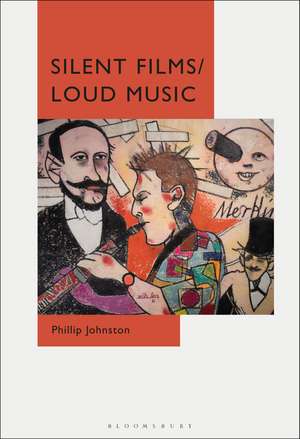Silent Films/Loud Music: New Ways of Listening to and Thinking about Silent Film Music
Autor Phillip Johnstonen Limba Engleză Paperback – 22 mar 2023
| Toate formatele și edițiile | Preț | Express |
|---|---|---|
| Paperback (1) | 191.31 lei 6-8 săpt. | |
| Bloomsbury Publishing – 22 mar 2023 | 191.31 lei 6-8 săpt. | |
| Hardback (1) | 568.80 lei 6-8 săpt. | |
| Bloomsbury Publishing – 8 sep 2021 | 568.80 lei 6-8 săpt. |
Preț: 191.31 lei
Preț vechi: 249.34 lei
-23% Nou
Puncte Express: 287
Preț estimativ în valută:
36.61€ • 38.30$ • 30.41£
36.61€ • 38.30$ • 30.41£
Carte tipărită la comandă
Livrare economică 03-17 aprilie
Preluare comenzi: 021 569.72.76
Specificații
ISBN-13: 9781501369582
ISBN-10: 150136958X
Pagini: 248
Dimensiuni: 152 x 229 x 25 mm
Greutate: 0.34 kg
Editura: Bloomsbury Publishing
Colecția Bloomsbury Academic
Locul publicării:New York, United States
ISBN-10: 150136958X
Pagini: 248
Dimensiuni: 152 x 229 x 25 mm
Greutate: 0.34 kg
Editura: Bloomsbury Publishing
Colecția Bloomsbury Academic
Locul publicării:New York, United States
Caracteristici
Establishes the concept of the "polysynchronous" film score and the relationship between music, image, and narrative in contemporary scores for silent film
Notă biografică
Phillip Johnston is a composer for contemporary and silent film and lecturer at the Sydney Conservatorium of Music, Australia.
Cuprins
Prelude1. Music for Silent Films: from Synchronicity to Polysynchronicity2. Scores for Silent Film: Then and Now 3. Opportunities in Contemporary Scores for Silent Film 4. Contemporary Scores for Silent Film: Four Case Studies5. The Application of Polysynchronicity: Five Case Studies6. Jazzin' the Silents: Jazz and Improvised Music in Contemporary Scores for Silent Film7. Imaginary Music: Scores for Modern Silent Films8. Wordless! Music for Comics and Graphic Novels Turns Time into Space (and Back Again)9. Silent Film Composers Speak!BibliographyAppendix 1 ScoresAppendix 2 InterviewIndex
Recenzii
Essential reading for anyone who is interested in the art of silent film accompaniment, both past and present. Johnston analyses silent film scores with the keen eye of someone who has created some of the seminal works in the field himself.
A handful of publications about silent film music have been written by composers who have equal credentials as scholars, and with this book Phillip Johnston has joined their esteemed ranks. It's high time for a book like this, one that engages with the phenomenon of new scores for old silent films. Johnston's rich and authoritative discussion probes the notion that new music for silent films is a form of re-examination, not only of the films but also of what film music can be.
Silent Films/Loud Music is a relentlessly fascinating book about how music occultly welds itself to image, to story, character and memory to create fascinating new alloys of art. Johnston argues that music never simply serves a film, it collaborates with images to create entirely surprising new imagistic effects. The act of creating a modern film score for a decades-old silent film involves a lively cooperation between the living and the dead; the latter are brought back to life, conditionally, for this important teamwork, their efforts warm as the quick, frequently resulting in airborne effects, complete and utter reorganizations of the film canon! It's exciting to comprehend, thanks to this ardent and beautifully researched book, just how much and how mysteriously music affects film, elevates it, reinvents it, and not just in the silents-and not just film either, but the narratives by which we come to understand our own lives. We're only beginning to understand everything, one realizes while reading these pages. Once it opens up new vistas of understanding, this book shows us the first few truly exciting steps we're about to take. Cinephiles! Read this book!
The book provides a valuable insight into the practice of writing music for silent film, both traditional and modern, in theoretical and historical ways, as well as from the perspective of the author's own creative practice.
Quite literally eye-opening.
A handful of publications about silent film music have been written by composers who have equal credentials as scholars, and with this book Phillip Johnston has joined their esteemed ranks. It's high time for a book like this, one that engages with the phenomenon of new scores for old silent films. Johnston's rich and authoritative discussion probes the notion that new music for silent films is a form of re-examination, not only of the films but also of what film music can be.
Silent Films/Loud Music is a relentlessly fascinating book about how music occultly welds itself to image, to story, character and memory to create fascinating new alloys of art. Johnston argues that music never simply serves a film, it collaborates with images to create entirely surprising new imagistic effects. The act of creating a modern film score for a decades-old silent film involves a lively cooperation between the living and the dead; the latter are brought back to life, conditionally, for this important teamwork, their efforts warm as the quick, frequently resulting in airborne effects, complete and utter reorganizations of the film canon! It's exciting to comprehend, thanks to this ardent and beautifully researched book, just how much and how mysteriously music affects film, elevates it, reinvents it, and not just in the silents-and not just film either, but the narratives by which we come to understand our own lives. We're only beginning to understand everything, one realizes while reading these pages. Once it opens up new vistas of understanding, this book shows us the first few truly exciting steps we're about to take. Cinephiles! Read this book!
The book provides a valuable insight into the practice of writing music for silent film, both traditional and modern, in theoretical and historical ways, as well as from the perspective of the author's own creative practice.
Quite literally eye-opening.
